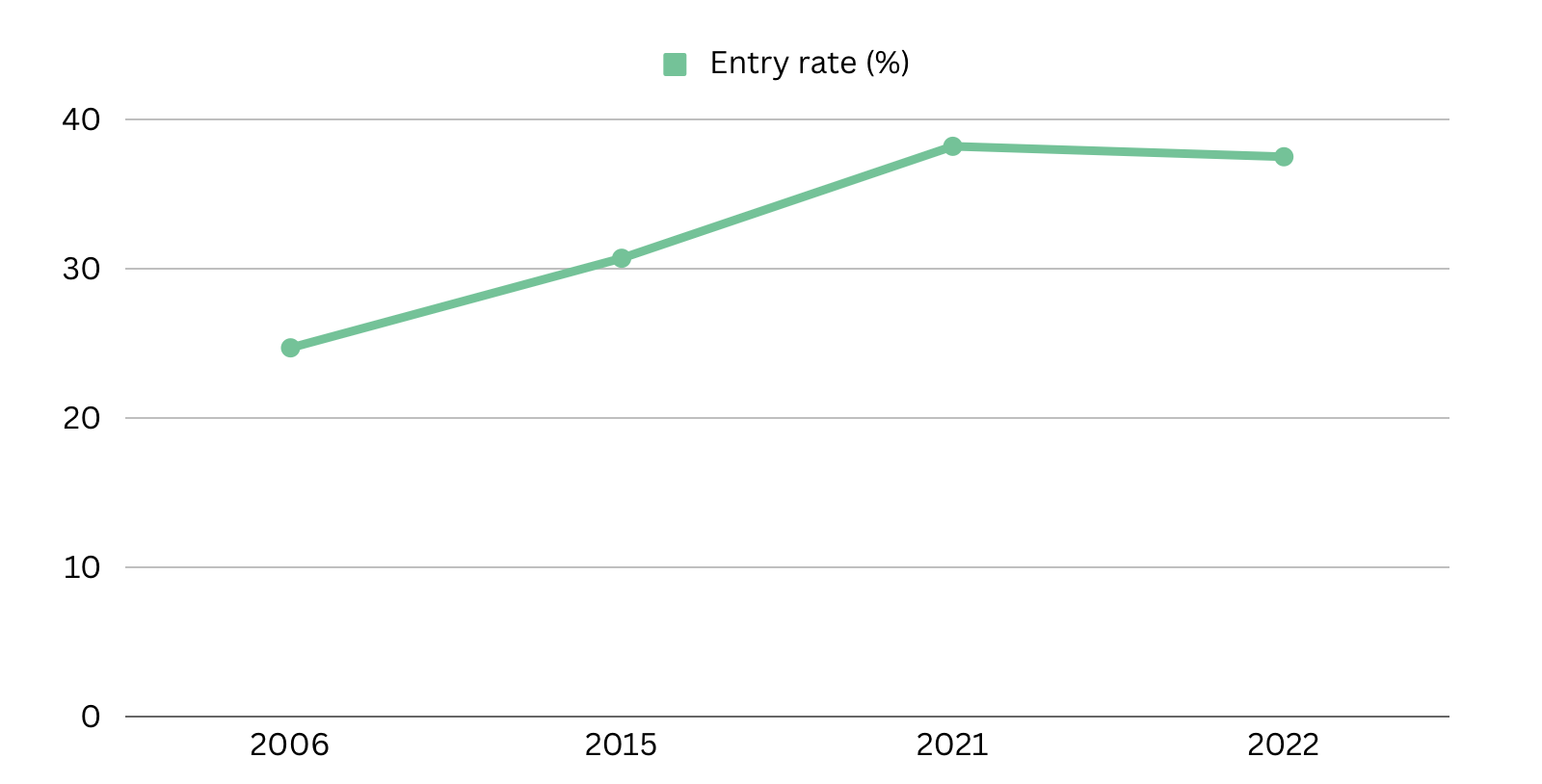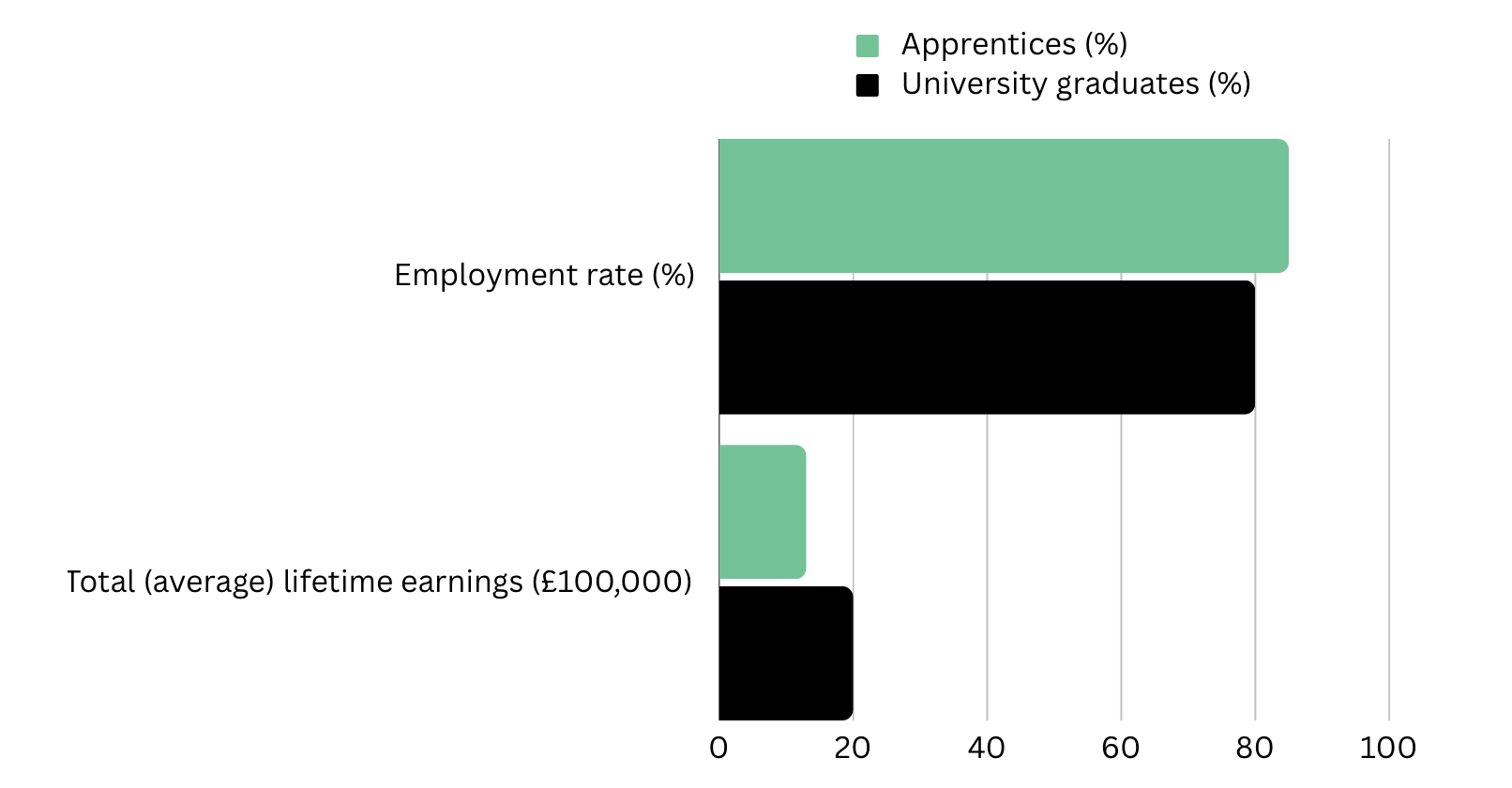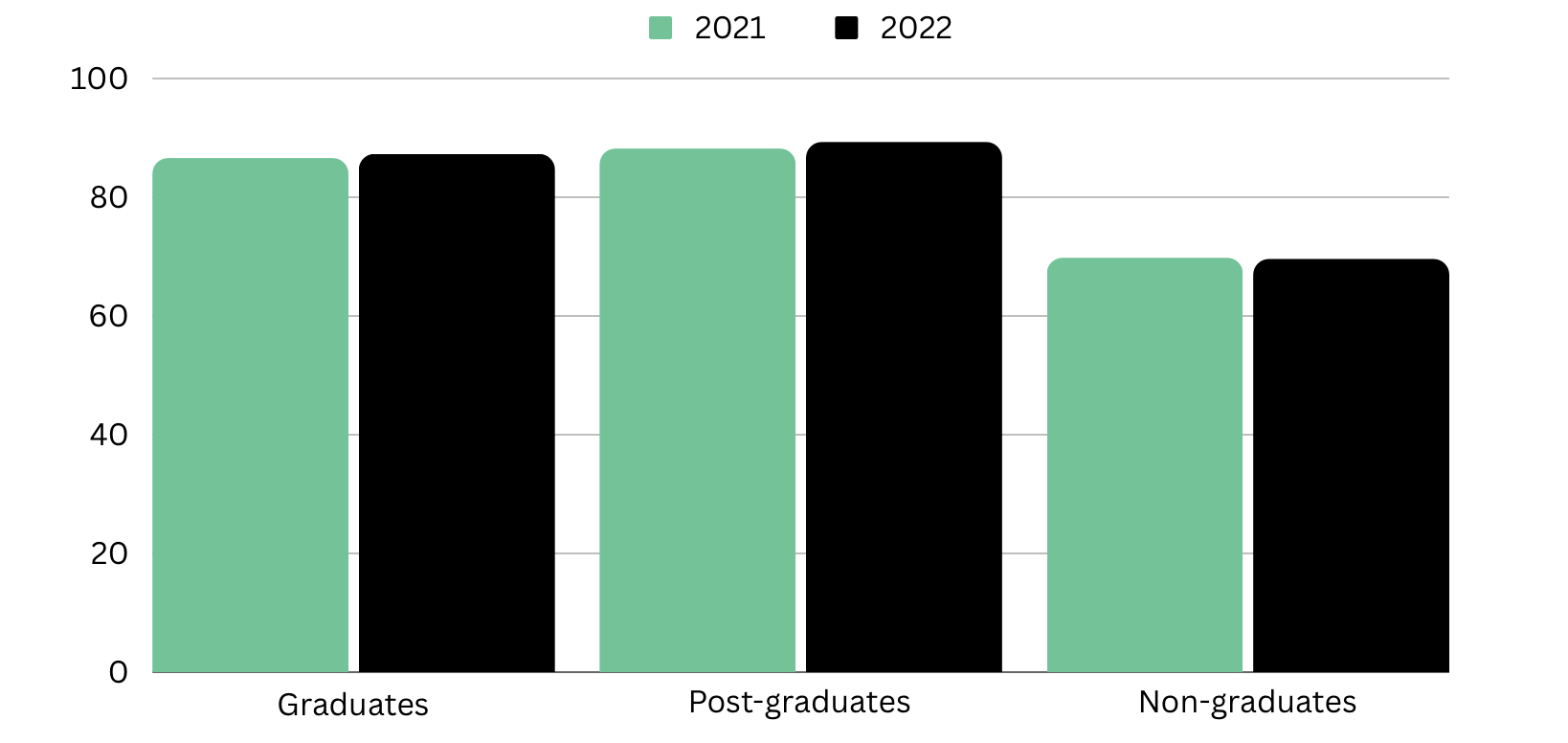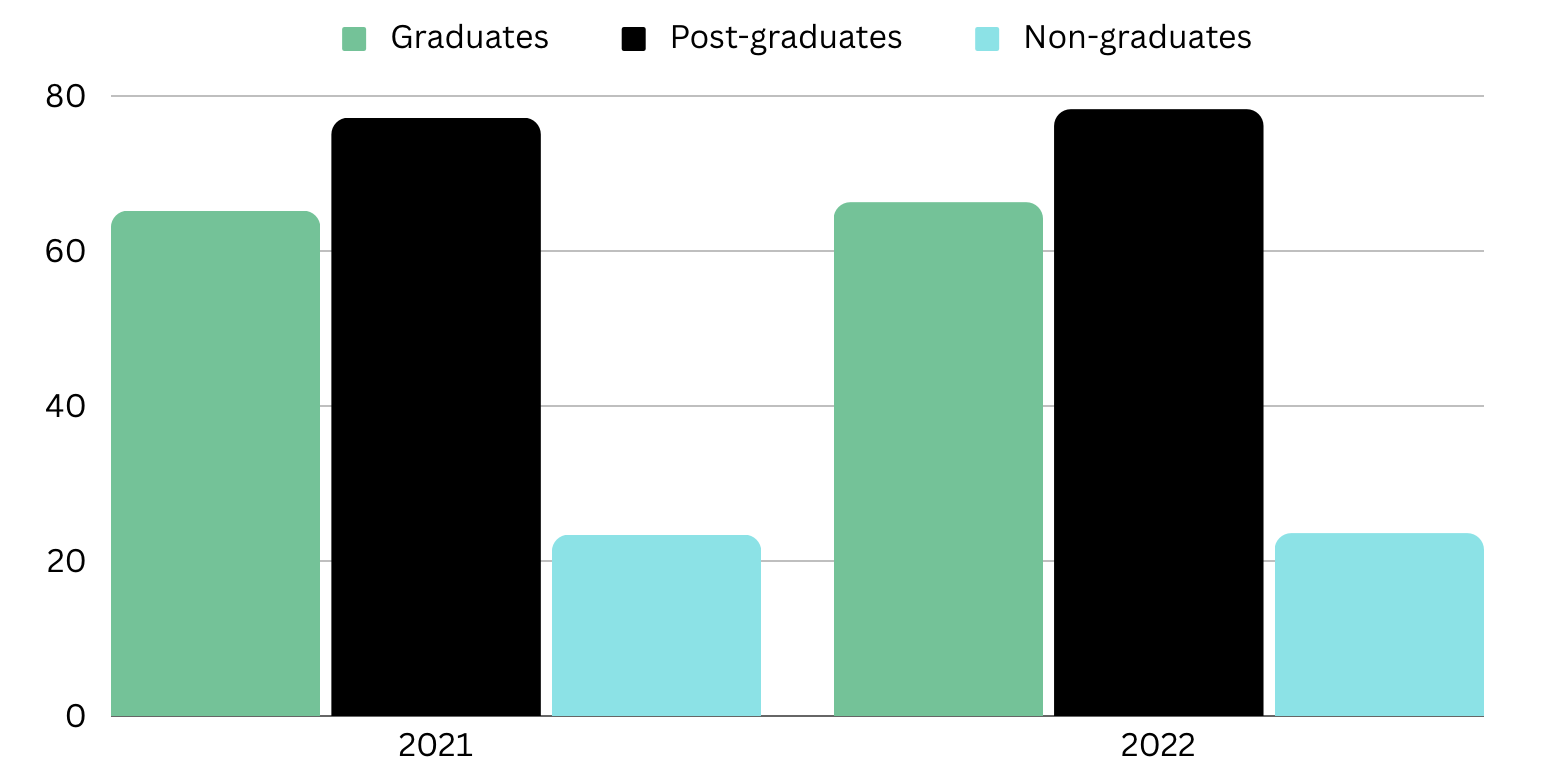The report discusses university attendance in the UK, its impact on employability, and alternative routes for school graduates. It highlights that family influence plays a significant role in career decisions, with those from university-educated families often preferring traditional degrees. Despite recent challenges, university enrollment has been on the rise, driven by domestic applicants.
Brexit led to a decline in EU student applications, but international student applications increased. The report discusses the pros and cons of apprenticeships, noting that they provide early income and can lead to better employment rates. However, the income potential varies, with Oxbridge or Russell Group degrees offering the highest lifetime earnings.
The report also addresses the cost of living crisis and increased tuition fees, leading more students to work part-time. It emphasizes that university degrees still offer better employment prospects compared to alternatives. Graduates and postgraduates have higher employment rates and earnings. The report includes several figures showing employment statistics and insights on business founders and employability by subject and graduation level.
In summary, the report provides data on university attendance, career decision factors, and alternative pathways, highlighting the employment prospects associated with each option and the impact of recent changes in the education landscape.
This report encompasses figures on university attendance levels in the UK; provides numerical insights into the role university will play in your employment story; and the efficacy of university attendance for employment security, showcasing alternative routes school graduates take today and how far these alternatives take them. We hope that these insights, shared with you, will diminish some educational anxieties, show you the transformation that the higher education sector is undergoing and show you the multiple ways in which you can secure employment comfortably.
Universities
The influence family members have on young people when they're making important decisions about their careers is significant.
A survey carried out by Prospects revealed that school students tend to heavily depend on their families for guidance regarding career choices, with 65% seeking advice from their parents, as opposed to 57% consulting teachers and 35% reaching out to careers professionals.
Notably, students with parents who have a university education exhibit a higher preference for traditional degree programs, as 43% of this group perceive a degree as having a superior reputation, and 13% indicated that they would not undertake an apprenticeship due to parental influence. Contrastingly, when considering students with parents who did not pursue a university education, approximately one-third expressed the belief that a degree holds a better reputation, and 8% reported parental opposition to apprenticeships.
Current university attendance trends suggest that recent current affairs have stagnated predicted growth; however, in comparison with the previous decade, recruitment numbers at UK Higher Education Institutions are still significantly higher. The rate of higher education enrollment among 18-year-old individuals in the UK witnessed a notable increase from 24.7% in 2006 to 30.7% in 2015, reaching its peak at 38.2% in 2021. Subsequently, in 2022, it experienced a slight dip, returning to 37.5%, which remains the second-highest level ever recorded. This increase can be attributed to a surge in applications from domestic students, rising by 2.1% in 2020 and further increasing by 5.1% in 2021. This trend was driven by both a larger population of 18-year-olds and an increased application rate for higher education among this age-group. (House of Commons, 2023).
Current university attendance trends suggest that recent current affairs have stagnated predicted growth; however, in comparison with the previous decade, recruitment numbers at UK Higher Education Institutions are still significantly higher. The rate of higher education enrollment among 18-year-old individuals in the UK witnessed a notable increase from 24.7% in 2006 to 30.7% in 2015, reaching its peak at 38.2% in 2021. Subsequently, in 2022, it experienced a slight dip, returning to 37.5%, which remains the second-highest level ever recorded. This increase can be attributed to a surge in applications from domestic students, rising by 2.1% in 2020 and further increasing by 5.1% in 2021. This trend was driven by both a larger population of 18-year-olds and an increased application rate for higher education among this age-group. (House of Commons, 2023).

Brexit led to a change in the fee structure for new EU students starting in 2021, rendering them ineligible for fee loans and subject to higher fees. Consequently, there was a substantial decline of 40% in applications from EU students in 2021. Moreover, the number of EU students enrolling on full-time undergraduate courses witnessed a sharp drop of 65% between 2020 and 2022, reaching its lowest level since 1994.
In contrast, applications from other international students surged to record levels in 2020, 2021, and 2022, despite concerns related to Covid-19. The overall count of accepted applicants through UCAS saw a substantial increase of 5.4% in 2020, establishing a new record high. However, in 2021, there was a decrease of 8,400 applicants, equating to a 1.5% decline. This decline was predominantly driven by a 50% decrease in accepted applicants from the EU. Nonetheless, acceptances from domestic applicants increased by 1.4%, and those from other international applicants rose by 2.4%.
In contrast, applications from other international students surged to record levels in 2020, 2021, and 2022, despite concerns related to Covid-19. The overall count of accepted applicants through UCAS saw a substantial increase of 5.4% in 2020, establishing a new record high. However, in 2021, there was a decrease of 8,400 applicants, equating to a 1.5% decline. This decline was predominantly driven by a 50% decrease in accepted applicants from the EU. Nonetheless, acceptances from domestic applicants increased by 1.4%, and those from other international applicants rose by 2.4%.

Alternative routes
Compulsory education in the UK requires children to study up to GCSE level, or 16 years old. Students are then presented with a range of educational choices to select from, with either completion of secondary education with final A-level examinations and eventual enrolment on a university course (the standard route) or Further Education options such as apprenticeships.
Apprenticeships are career orientated options, where you learn on the job. Partaking in an apprenticeship allows you to start earning a salary right from the beginning, in contrast to pursuing a university degree where you must wait until you have finished your studies to start earning. Consequently, as an apprentice, you can accumulate a few additional years of income without the burden of student debt. It's worth noting that some employers may go a step further by offering apprentices higher wages than the national minimum wage.
The standard school model is designed to persuade students to follow the standard route to university, which poses certain disadvantages to those students who do not choose to or cannot attend university. CIPD found that just 1% of all young people received help and support to apply for an apprenticeship during their time at school. In comparison, 59% received support from their school on their educational and academic options such as applying for university or college. In the 2021/22 academic year, the number of under-19 students pursuing an apprenticeship (77,500) was dwindled by the number of students the same age who chose to pursue a university degree (1,037,155).
In terms of employment numbers, however, apprentices expectedly perform better compared to university graduates with 80% of university graduates in employment, but 85% of apprentices in employment (with 64% remaining with their apprenticeship employer). However this does not necessarily signify higher income.
Apprenticeships are career orientated options, where you learn on the job. Partaking in an apprenticeship allows you to start earning a salary right from the beginning, in contrast to pursuing a university degree where you must wait until you have finished your studies to start earning. Consequently, as an apprentice, you can accumulate a few additional years of income without the burden of student debt. It's worth noting that some employers may go a step further by offering apprentices higher wages than the national minimum wage.
The standard school model is designed to persuade students to follow the standard route to university, which poses certain disadvantages to those students who do not choose to or cannot attend university. CIPD found that just 1% of all young people received help and support to apply for an apprenticeship during their time at school. In comparison, 59% received support from their school on their educational and academic options such as applying for university or college. In the 2021/22 academic year, the number of under-19 students pursuing an apprenticeship (77,500) was dwindled by the number of students the same age who chose to pursue a university degree (1,037,155).
In terms of employment numbers, however, apprentices expectedly perform better compared to university graduates with 80% of university graduates in employment, but 85% of apprentices in employment (with 64% remaining with their apprenticeship employer). However this does not necessarily signify higher income.
Research by The Sutton Trust concluded that apprenticeships had significantly higher earning potential than having no qualifications or only A-levels, and a level-5 apprenticeship resulted in higher earnings than a degree from a non-Russell Group university. However, an Oxbridge or Russell Group degree resulted in the highest average lifetime earnings.

In 2015, the government introduced degree apprenticeships, which involve workplace training in addition to university attendance to work towards a full Bachelor’s or Master’s degree.
Employment
The cost of living crisis and increased tuition fees are putting significant pressure on the student population. Whether it is the circumstances, or the pro-labour attitudes of GenZ, numbers of employed students are on the rise. A report by HEIP has found that, today, more students are in paid work (55%) than not (45%); Students in paid employment working an average of 13.5 hours per week; 76% of the students surveyed reported a negative impact on study due to the cost of living.
Coming out of university, however, it yet remains unarguable that a university level degree prepares you better for employment than any alternative option.
Working-age graduates and postgraduates continue to have higher employment rates than non-graduates. The employment rates for both graduates and postgraduates increased in 2022 compared to 2021, with postgraduates having the largest increase. There was a small decrease in employment rates for working-age non-graduates.

In 2022, the employment rate for working-age graduates (those aged 16 - 64) was 87.3%, an increase of 0.6 percentage points in 2021 (86.6%). For working-age postgraduates, the employment rate was 89.3%, an increase of 1.1 percentage points in 2021 (88.2%). For working-age non-graduates, the employment rate was 69.6%, a decrease of 0.2 percentage points from 2021 (69.8%).
In 2022, 66.3% of working-age graduates were in high-skilled employment, compared to 78.3% of postgraduates and 23.6% of non-graduates. In 2022, the percentage of working-age graduates and postgraduates in high-skilled employment was 1.1 percentage points higher than in 2021. The percentage of working-age non-graduates in high-skilled employment increased by 0.2 percentage points compared to 2021.
In 2022, 66.3% of working-age graduates were in high-skilled employment, compared to 78.3% of postgraduates and 23.6% of non-graduates. In 2022, the percentage of working-age graduates and postgraduates in high-skilled employment was 1.1 percentage points higher than in 2021. The percentage of working-age non-graduates in high-skilled employment increased by 0.2 percentage points compared to 2021.

In 2022, the median nominal salary for working-age graduates was £38,500. This was £11,500 more than working-age non-graduates (£27,000), but £6,500 less than working-age postgraduates (£45,000).

Interesting insights: What universities produce the highest number of business founders?

Graduates of what subjects are most employable?

What level of graduation is the most likely to ensure you are employed?

Highest graduate employee output universities

References:
Fennell, A. (2023, March 7). UK Graduate Statistics & Employment Rates: 2023 analysis. StandOut CV | CV writing advice, CV examples and templates. https://standout-cv.com/uk-graduate-statistics
Bolton, P. (2023a, February 21). Higher education student numbers - House of Commons Library. Higher education student numbers. https://commonslibrary.parliament.uk/research-briefings/cbp-7857/
What percentage of apprentices stay in employment. Simply Academy. (2022, April 28). https://www.simplyacademy.com/employment-after-apprenticeship/
Kirby, P. (2015, October). Potential for success - sutton trust. LEVELS OF SUCCESS: The potential of UK apprenticeships. https://www.suttontrust.com/wp-content/uploads/2019/12/PotentialForSuccess.pdf
Stephenson, R. (2023, June 22). Students’ improving academic experience overshadowed by cost-of-living crisis: Hepi / ADVANCE HE 2023 student academic experience survey. HEPI. https://www.hepi.ac.uk/2023/06/22/student-experience-academic-survey-2023/
Ghoshal, P. (2022, October 7). Apprenticeships vs University: Everything You Need To Know. FDM Group. https://www.fdmgroup.com/blog/apprenticeship-vs-university/
Smith, M.-S., & Greaves, L. (2022). Introduction. https://publications.prospects.ac.uk/early-careers-survey-2022/
Half of graduates would have considered doing an apprenticeship instead of a degree, new CIPD report finds. CIPD. (2021, November 17). https://www.cipd.org/uk/about/press-releases/171121half-graduates-considered-apprenticeship/
Higher Education Student Statistics: UK 2021/22 released. HESA. (2023, January 19). https://www.hesa.ac.uk/news/19-01-2023/higher-education-student-statistics-uk-202122-released
Brown, L., Welsby, M., & Roberts, D. (2022, July 5). Understanding changes in self-employment in the UK: January 2019 to March 2022. Understanding changes in self-employment in the UK - Office for National Statistics. https://www.ons.gov.uk/employmentandlabourmarket/peopleinwork/employmentandemployeetypes/articles/understandingchangesinselfemploymentintheuk/january2019tomarch2022
Dickerson, A., McDool, E., & Morris, D. (2022, April 25). Full article: Post-compulsory education pathways and labour market outcomes. Post-compulsory education pathways and labour market outcomes. https://www.tandfonline.com/doi/full/10.1080/09645292.2022.2068137
Fennell, A. (2023, March 7). UK Graduate Statistics & Employment Rates: 2023 analysis. StandOut CV | CV writing advice, CV examples and templates. https://standout-cv.com/uk-graduate-statistics
Bolton, P. (2023a, February 21). Higher education student numbers - House of Commons Library. Higher education student numbers. https://commonslibrary.parliament.uk/research-briefings/cbp-7857/
What percentage of apprentices stay in employment. Simply Academy. (2022, April 28). https://www.simplyacademy.com/employment-after-apprenticeship/
Kirby, P. (2015, October). Potential for success - sutton trust. LEVELS OF SUCCESS: The potential of UK apprenticeships. https://www.suttontrust.com/wp-content/uploads/2019/12/PotentialForSuccess.pdf
Stephenson, R. (2023, June 22). Students’ improving academic experience overshadowed by cost-of-living crisis: Hepi / ADVANCE HE 2023 student academic experience survey. HEPI. https://www.hepi.ac.uk/2023/06/22/student-experience-academic-survey-2023/
Ghoshal, P. (2022, October 7). Apprenticeships vs University: Everything You Need To Know. FDM Group. https://www.fdmgroup.com/blog/apprenticeship-vs-university/
Smith, M.-S., & Greaves, L. (2022). Introduction. https://publications.prospects.ac.uk/early-careers-survey-2022/
Half of graduates would have considered doing an apprenticeship instead of a degree, new CIPD report finds. CIPD. (2021, November 17). https://www.cipd.org/uk/about/press-releases/171121half-graduates-considered-apprenticeship/
Higher Education Student Statistics: UK 2021/22 released. HESA. (2023, January 19). https://www.hesa.ac.uk/news/19-01-2023/higher-education-student-statistics-uk-202122-released
Brown, L., Welsby, M., & Roberts, D. (2022, July 5). Understanding changes in self-employment in the UK: January 2019 to March 2022. Understanding changes in self-employment in the UK - Office for National Statistics. https://www.ons.gov.uk/employmentandlabourmarket/peopleinwork/employmentandemployeetypes/articles/understandingchangesinselfemploymentintheuk/january2019tomarch2022
Dickerson, A., McDool, E., & Morris, D. (2022, April 25). Full article: Post-compulsory education pathways and labour market outcomes. Post-compulsory education pathways and labour market outcomes. https://www.tandfonline.com/doi/full/10.1080/09645292.2022.2068137








